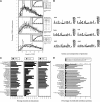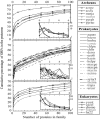Comparing function and structure between entire proteomes
- PMID: 11567088
- PMCID: PMC2374214
- DOI: 10.1110/ps.10101
Comparing function and structure between entire proteomes
Abstract
More than 30 organisms have been sequenced entirely. Here, we applied a variety of simple bioinformatics tools to analyze 29 proteomes for representatives from all three kingdoms: eukaryotes, prokaryotes, and archaebacteria. We confirmed that eukaryotes have relatively more long proteins than prokaryotes and archaes, and that the overall amino acid composition is similar among the three. We predicted that approximately 15%-30% of all proteins contained transmembrane helices. We could not find a correlation between the content of membrane proteins and the complexity of the organism. In particular, we did not find significantly higher percentages of helical membrane proteins in eukaryotes than in prokaryotes or archae. However, we found more proteins with seven transmembrane helices in eukaryotes and more with six and 12 transmembrane helices in prokaryotes. We found twice as many coiled-coil proteins in eukaryotes (10%) as in prokaryotes and archaes (4%-5%), and we predicted approximately 15%-25% of all proteins to be secreted by most eukaryotes and prokaryotes. Every tenth protein had no known homolog in current databases, and 30%-40% of the proteins fell into structural families with >100 members. A classification by cellular function verified that eukaryotes have a higher proportion of proteins for communication with the environment. Finally, we found at least one homolog of experimentally known structure for approximately 20%-45% of all proteins; the regions with structural homology covered 20%-30% of all residues. These numbers may or may not suggest that there are 1200-2600 folds in the universe of protein structures. All predictions are available at http://cubic.bioc.columbia.edu/genomes.
Figures





References
-
- 1997. The Yeast Genome Directory. Nature 387 5. - PubMed
-
- 1998. Genome sequence of the nematode C. elegans: A platform for investigating biology. The C. elegans Sequencing Consortium (publ. errata appear in Science 1999, 283: 35, 283: 2103, 285: 1493). Science 288 2012–2018. - PubMed
-
- Adams, M.D., Celniker, S.E., Holt.A., Evans, C.A., Gocayne, J.D., Amanatides, P.G., Scherer, S.E., Li, P.W., Hoskins, R.A., Galle, R.F., et al. 2000. The genome sequence of Drosophila melanogaster. Science 287 2185–2195. - PubMed
-
- Andersson, S.G., Zomorodipour, A., Andersson, J.O., Sicheritz-Ponten, T., Alsmark, U.C., Podowski, R.M., Naslund, A.K., Eriksson, A.S., Winkler, H.H., and Kurland, C.G. 1998. The genome sequence of Rickettsia prowazekii and the origin of mitochondria. Nature 396 133–140. - PubMed
Publication types
MeSH terms
Substances
Grants and funding
LinkOut - more resources
Full Text Sources

